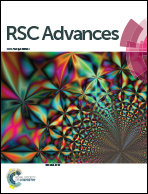Al2O3/yttrium compound core–shell structure formation with burst nucleation: a process driven by electrostatic attraction and high surface energy†
Abstract
A partial wet chemical route has been developed, in which aluminium oxide (Al2O3) nanoparticles in a Y(NO3)3 solution are induced to form a core–shell-structured yttrium aluminum garnet (YAG) precursor based on a burst nucleation synthesis. By simulating the reaction conditions with urea and ammonium bicarbonate as precipitants, a two-step mechanism involving different dynamic processes is proposed to describe the core–shell structure formation. During the majority of the process, the electrostatic attraction between the opposite surface charges of Al2O3 and nanoparticles of the Y-compound is regarded as the single driving force. However, the high surface energy of Y-compound nanoparticles originating from the burst nucleation process plays a key role in completing the formation of the core–shell structure. The precursor obtained can be transformed into pure YAG nanoparticles, which retain the morphology of the Al2O3 template, and these are of sufficiently high quality for the preparation of transparent ceramics. An understanding of the mechanism makes this a novel method for the synthesis of the nanostructured core–shell binary oxide precursor.


 Please wait while we load your content...
Please wait while we load your content...